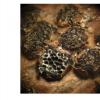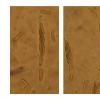
24-12-2025 17:08
Hulda Caroline HolteHello, I have found this propoloid ascomycete on

21-12-2025 09:32
Hello.A tiny ascomycete found embedded in wood in

21-12-2025 21:32
Pol DebaenstHello, Garden, Burgweg 19, Veurne, BelgiumOn 10/1

22-12-2025 23:38
Patrice TANCHAUDBonsoir, récolte sur un mur en pierre, apothéci

22-12-2025 00:47
Patrice TANCHAUDBonsoir, récolte à proximité du milieu dunaire
Diatrype polycocca on Acer negundo ?
Alex Akulov,
28-09-2013 23:32
 Dear Friends,
Dear Friends,Today on the dead fallen branches of Acer negundo I have collected interesting Diatrype sample, looking like Diatrype polycocca. Asci are 8-sporous, long stipitate, the length of the sporiferous parts are 51-54 (single 70) micrometers, the width - (6.5) 7,1-10,6 micrometers, the length of stipes are 44-70 micrometers. Ascospores allantoid, smoky-brown, 10,9-11,9 x 2.2-2.4 microns.
Did you know this species?
According available at me information, this species was described on Acer opaca from Switzerland and recently was found on Acer platanoides in Poland and on ? Cornus in France.
Waiting for your answer,
Alex
Paul LEROY,
03-10-2013 22:58
Re : Diatrype polycocca on Acer negundo ?
Hello Alex,
Apparemment cette Diatrypaceae pourrait plutôt être: Eutypella leprosa. Cette espèce est
très commune sur arbres feuillus variés et son entostroma blanc conduit plutôt à chercher
vers le genre Diatrype. L'appareil apical est J+ mais est souvent peu visible, même après
prétraitement KOH.
Cordialement
Paul
Apparemment cette Diatrypaceae pourrait plutôt être: Eutypella leprosa. Cette espèce est
très commune sur arbres feuillus variés et son entostroma blanc conduit plutôt à chercher
vers le genre Diatrype. L'appareil apical est J+ mais est souvent peu visible, même après
prétraitement KOH.
Cordialement
Paul
Alex Akulov,
06-10-2013 15:43

Re : Diatrype polycocca on Acer negundo ?
Paul, merci beaucoup pour vos conseils!

